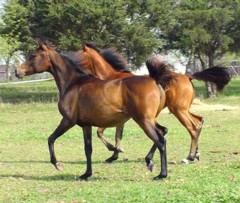|
Trot
The trot, however, is a two-beat gait; the diagonal legs are moved synchronously. The footfalls in sequence are left fore with right hind and right fore with left hind.
 photo courtesy of Linda Harper
photo courtesy of Linda Harper
|
Canter
At the canter, one foreleg leads while the other foreleg and its diagonal hindleg move together, and the other hind leg moves independently. This is thus a three-beat gait, with a footfall sequence (with a left fore lead) of right hind, then left hind with right fore, followed by left fore. There is a period of suspension after the leading foreleg leaves the ground.
Gallop
In the gallop, the stride lengthens and the period of suspension is also increased. At the same time, the legs that were working in a diagonal at the canter are unable to do so at this faster pace. They become separated, so that the hind leg hits the ground slightly before the diagonal foreleg.
The footfall sequence (with a left fore lead) is right hind, followed by left hind slightly before right fore, followed by left fore. The gallop is therefore a four-beat gait. In the canter and gallop, either foreleg may lead while going in a straight line, but it is usually the inner leg that leads on a bend. The leading leg has to take more weight and do more work than its opposite number. Tired horses often change legs in mid-gallop for this reason.
|